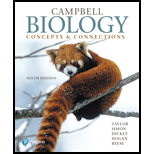
Concept explainers
To enlist:
The characteristics and representatives of the given animal phyla.
Introduction:
Animal phyla include a list of the major groups of animals that include invertebrates and vertebrates. Invertebrates are the animals that do not have a backbone and the vertebrates are the backbone bearing animals.
Explanation of Solution
The key characteristics and the representatives of the animal phyla are described in the following table.
|
Phylum |
Characteristics |
Representatives |
|
Sponges |
They are included in phylum porifera. It is a simple animal with no mouth, heart or muscles. It is sessile animal containing many pores and cells for filter feeding. Asymmetrical. |
Sponges and common bath sponge. |
|
Cnidarians |
They are aquatic animals. Coelom is absent. They contain cnidocyte cells to capture prey. Radial symmetry. |
Sea anemone, jellyfish, corals and Obelia. |
|
|
Included in phylum Platyhelminthes. No body cavity. Bilateral symmetry. |
Planaria and tape worms. |
|
Nematodes |
They have complete |
Roundworms and hookworms. |
|
Molluscs |
They have a soft and unsegmented body. Have mantle and the muscular foot. |
Snails, squids, octopus and mussels. |
|
Annelida |
They are the true segmented worms. Have closed circulatory system. |
Earthworms and leeches. |
|
Arthropods |
Presence of jointed legs, antennae, exoskeleton and closed circulatory system. Bilateral symmetry. |
Insects, crab and millipedes. |
|
Echinoderms |
They have spiny skin, water vascular system, body containing 5 equal segments and tube feet. Radial symmetry. |
Star fish and sea urchin. |
|
Chordates |
Presence of notochord, dorsal nerve chord, gill slits and bilateral symmetry. |
Mammals, fish, birds, reptiles and amphibians. |
Want to see more full solutions like this?
Chapter 18 Solutions
Campbell Biology: Concepts & Connections (9th Edition)
- Can you described the image? Can you explain the question as well their answer and how to get to an answer to an problem like this?arrow_forwardglg 112 mid unit assignment Identifying melting processesarrow_forwardGive only the mode of inheritance consistent with all three pedigrees and only two reasons that support this, nothing more, (it shouldn't take too long)arrow_forward
- Oarrow_forwardDescribe the principle of homeostasis.arrow_forwardExplain how the hormones of the glands listed below travel around the body to target organs and tissues : Pituitary gland Hypothalamus Thyroid Parathyroid Adrenal Pineal Pancreas(islets of langerhans) Gonads (testes and ovaries) Placentaarrow_forward
- What are the functions of the hormones produced in the glands listed below: Pituitary gland Hypothalamus Thyroid Parathyroid Adrenal Pineal Pancreas(islets of langerhans) Gonads (testes and ovaries) Placentaarrow_forwardDescribe the hormones produced in the glands listed below: Pituitary gland Hypothalamus Thyroid Parathyroid Adrenal Pineal Pancreas(islets of langerhans) Gonads (testes and ovaries) Placentaarrow_forwardPlease help me calculate drug dosage from the following information: Patient weight: 35 pounds, so 15.9 kilograms (got this by dividing 35 pounds by 2.2 kilograms) Drug dose: 0.05mg/kg Drug concentration: 2mg/mLarrow_forward
- A 25-year-old woman presents to the emergency department with a 2-day history of fever, chills, severe headache, and confusion. She recently returned from a trip to sub-Saharan Africa, where she did not take malaria prophylaxis. On examination, she is febrile (39.8°C/103.6°F) and hypotensive. Laboratory studies reveal hemoglobin of 8.0 g/dL, platelet count of 50,000/μL, and evidence of hemoglobinuria. A peripheral blood smear shows ring forms and banana-shaped gametocytes. Which of the following Plasmodium species is most likely responsible for her severe symptoms? A. Plasmodium vivax B. Plasmodium ovale C. Plasmodium malariae D. Plasmodium falciparumarrow_forwardStandard Concentration (caffeine) mg/L Absorbance Reading 10 0.322 20 0.697 40 1.535 60 2.520 80 3.100arrow_forwardPlease draw in the missing answer, thank youarrow_forward
 Concepts of BiologyBiologyISBN:9781938168116Author:Samantha Fowler, Rebecca Roush, James WisePublisher:OpenStax College
Concepts of BiologyBiologyISBN:9781938168116Author:Samantha Fowler, Rebecca Roush, James WisePublisher:OpenStax College
 Biology (MindTap Course List)BiologyISBN:9781337392938Author:Eldra Solomon, Charles Martin, Diana W. Martin, Linda R. BergPublisher:Cengage Learning
Biology (MindTap Course List)BiologyISBN:9781337392938Author:Eldra Solomon, Charles Martin, Diana W. Martin, Linda R. BergPublisher:Cengage Learning Biology 2eBiologyISBN:9781947172517Author:Matthew Douglas, Jung Choi, Mary Ann ClarkPublisher:OpenStax
Biology 2eBiologyISBN:9781947172517Author:Matthew Douglas, Jung Choi, Mary Ann ClarkPublisher:OpenStax Biology: The Dynamic Science (MindTap Course List)BiologyISBN:9781305389892Author:Peter J. Russell, Paul E. Hertz, Beverly McMillanPublisher:Cengage Learning
Biology: The Dynamic Science (MindTap Course List)BiologyISBN:9781305389892Author:Peter J. Russell, Paul E. Hertz, Beverly McMillanPublisher:Cengage Learning Biology Today and Tomorrow without Physiology (Mi...BiologyISBN:9781305117396Author:Cecie Starr, Christine Evers, Lisa StarrPublisher:Cengage Learning
Biology Today and Tomorrow without Physiology (Mi...BiologyISBN:9781305117396Author:Cecie Starr, Christine Evers, Lisa StarrPublisher:Cengage Learning





